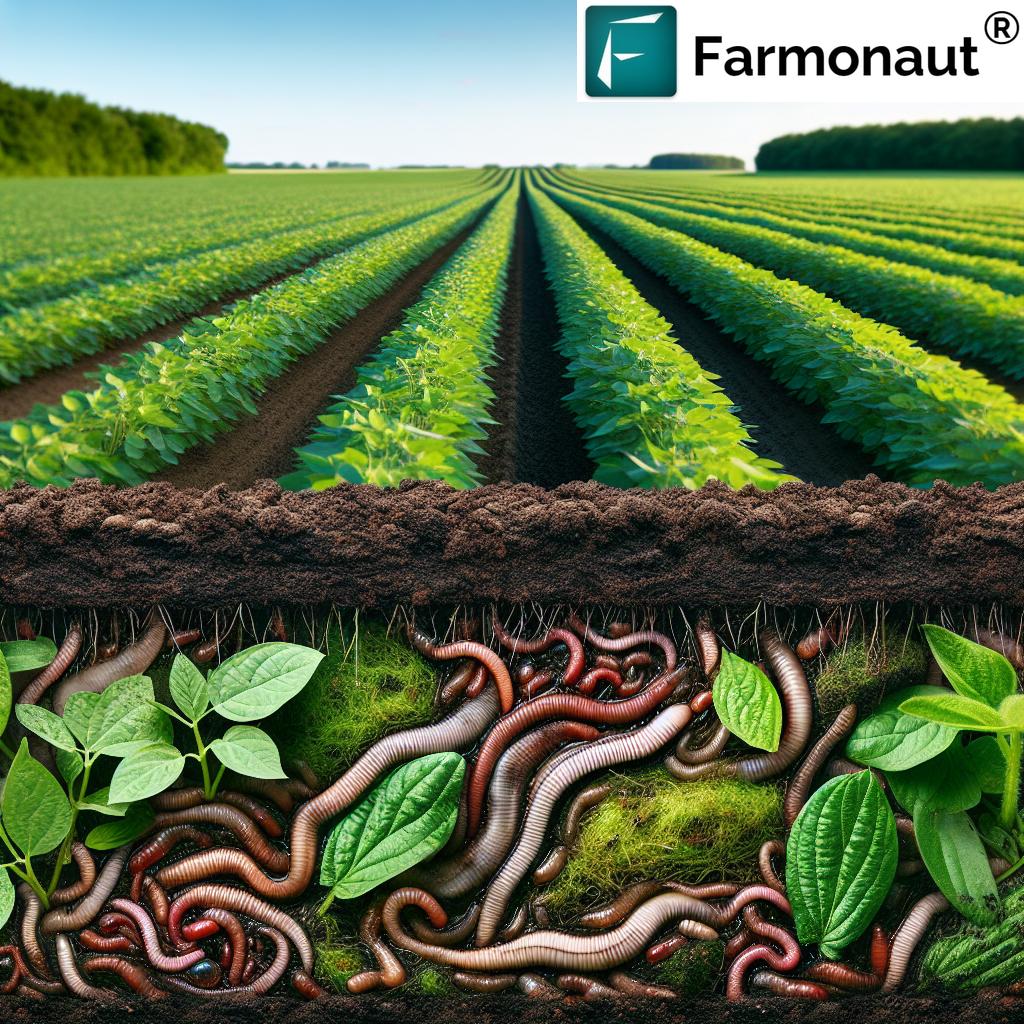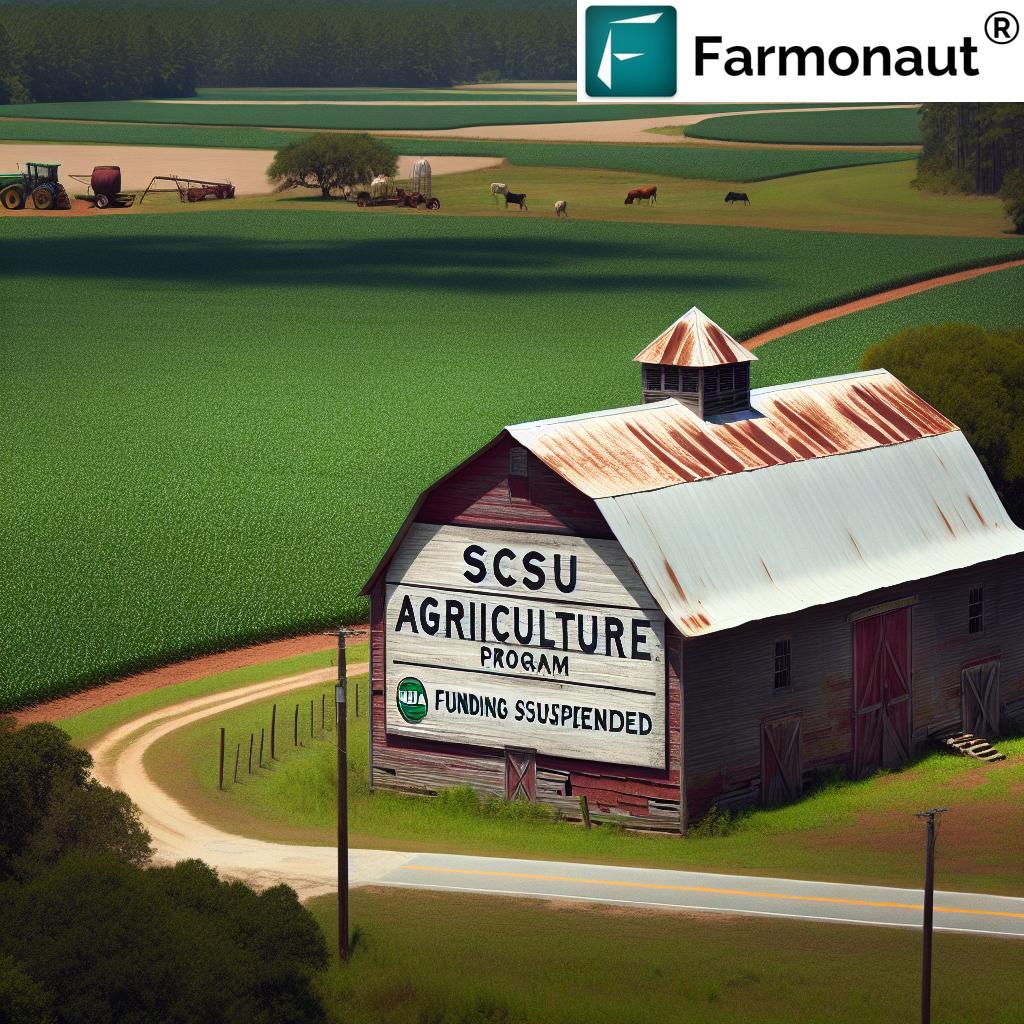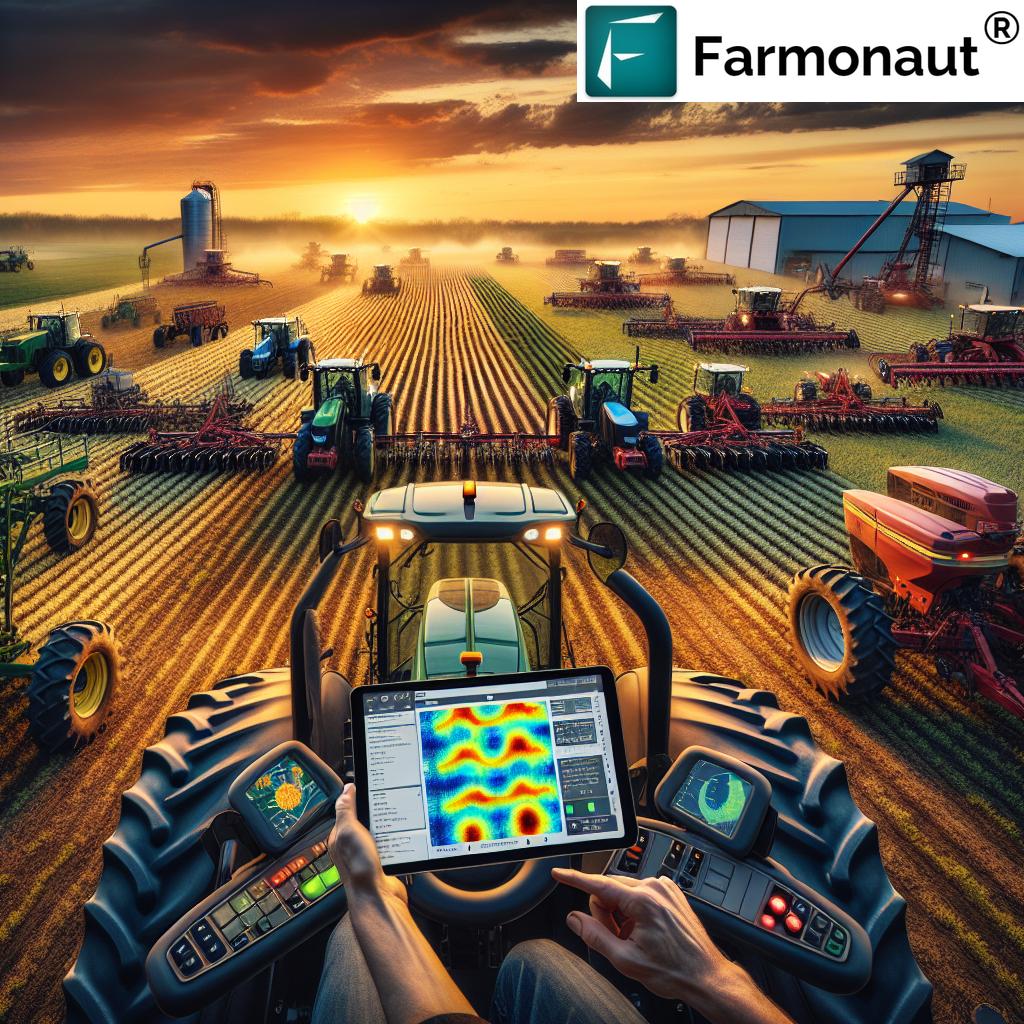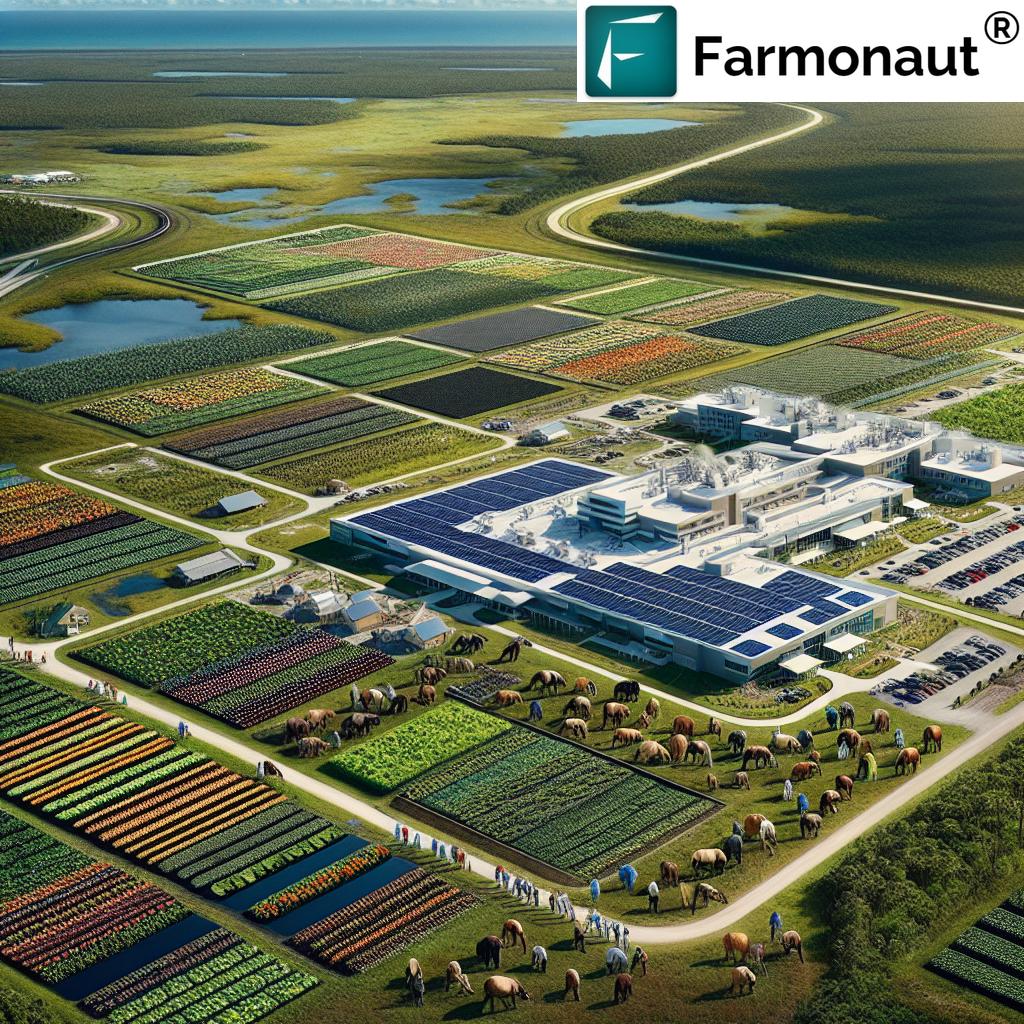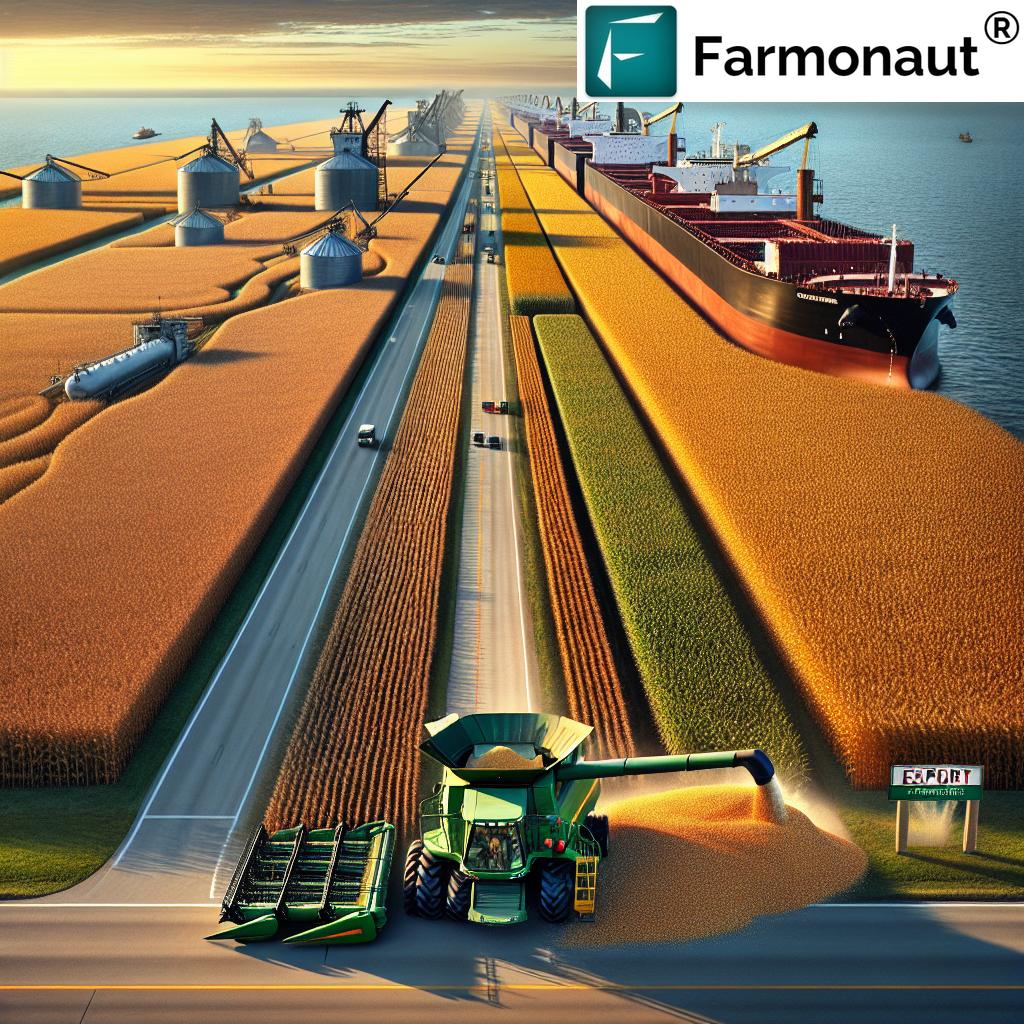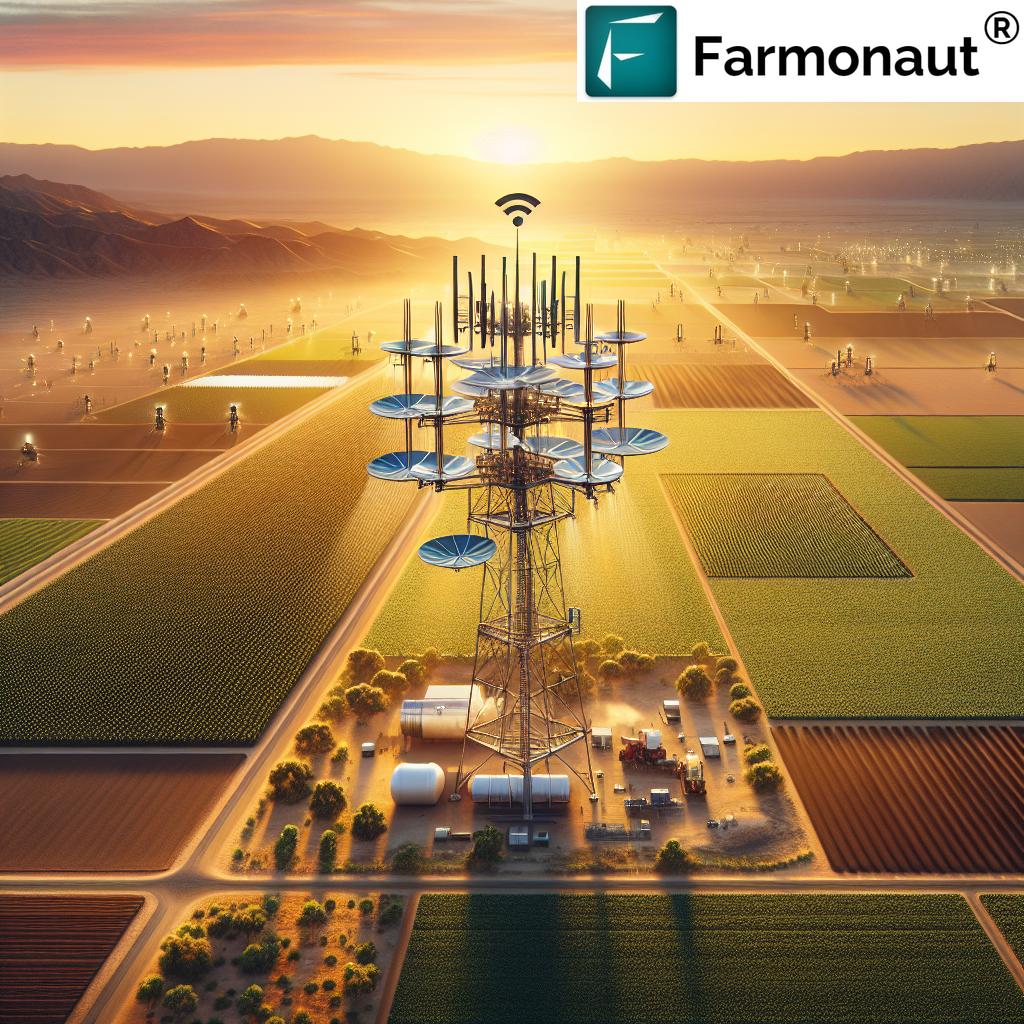Revolutionizing Sustainable Agriculture: How Bee Vectoring Technology is Transforming Crop Protection in Georgia’s Blueberry Fields
“Bee vectoring technology can reduce fungicide use by up to 98% in blueberry fields, promoting sustainable agriculture.”
In the heart of Georgia’s lush blueberry fields, a quiet revolution is taking place. As we delve into the world of sustainable agriculture technology, we’re witnessing a remarkable transformation in crop protection methods. The buzz isn’t just about the bees; it’s about how these industrious pollinators are becoming pivotal players in organic pest management solutions. At Farmonaut, we’re excited to bring you the latest insights on this groundbreaking approach that’s not only enhancing agricultural productivity but also prioritizing environmental protection.
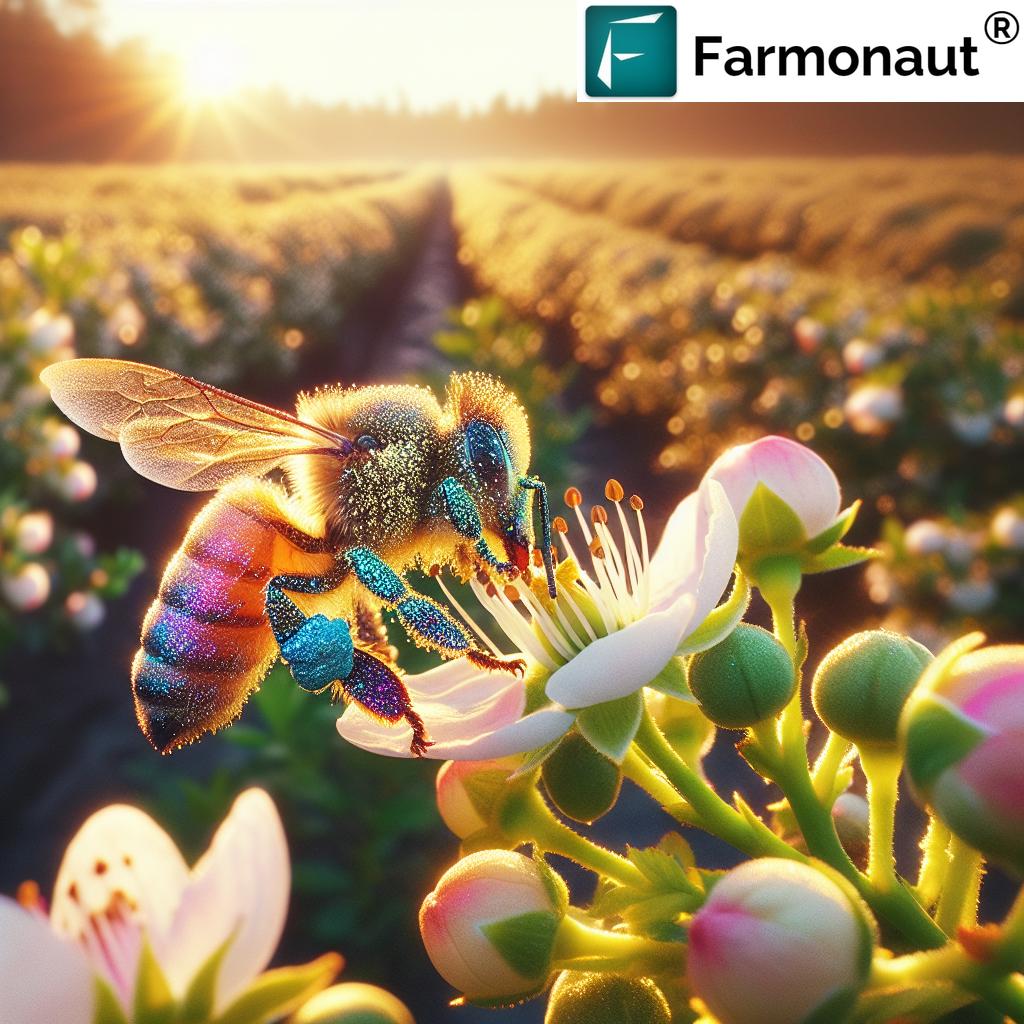
As we explore the innovative farming practices reshaping the agricultural landscape, it’s crucial to understand the role of precision agriculture techniques in this transformation. Bee vectoring technology stands at the forefront of these advancements, offering a unique and effective approach to crop protection that aligns perfectly with the principles of sustainable food production methods.
Understanding Bee Vectoring Technology
Bee vectoring technology is a revolutionary approach to crop protection that harnesses the natural behavior of bees to deliver biological control agents directly to crop flowers. This method represents a significant leap forward in sustainable agriculture technology, offering an eco-friendly alternative to traditional pesticide applications.
- How it works: The process involves placing a tray containing organic, bee-friendly plant protection products (usually a powdered form of beneficial microbes) at the entrance of beehives. As bees exit the hive, they walk through this powder, which adheres to their bodies.
- Precision delivery: During their pollination rounds, bees inadvertently deposit tiny amounts of this powder onto each flower they visit, providing targeted protection against various crop diseases and pests.
- Continuous application: This method ensures a consistent and ongoing application throughout the flowering period, offering superior coverage compared to traditional spray methods.
The adoption of bee vectoring for crop protection is gaining traction, particularly in high-value crops like blueberries, strawberries, and sunflowers. In Georgia’s blueberry fields, this technology is proving to be a game-changer in combating persistent issues like mummy berry disease, a fungal pathogen that can significantly impact crop yields.
The Impact on Georgia’s Blueberry Industry
Georgia, known for its thriving blueberry industry, has been at the forefront of adopting innovative farming practices. The introduction of bee vectoring technology in these fields is addressing several critical challenges:
- Mummy Berry Control: This fungal disease, caused by Monilinia vaccinii-corymbosi, has long been a bane for blueberry growers. Bee vectoring technology delivers targeted biofungicides directly to blueberry flowers, significantly reducing the incidence of mummy berry.
- Enhanced Pollination: Beyond disease control, this method ensures thorough pollination, which is crucial for optimal fruit set and yield in blueberries.
- Reduced Chemical Usage: By leveraging bees as natural vectors, growers can dramatically reduce their reliance on chemical fungicides, aligning with consumer demands for cleaner, more sustainably produced food.
The adoption of this technology is not just a win for growers; it’s a significant step towards more sustainable and environmentally friendly agricultural practices. As we at Farmonaut continue to monitor these developments, we’re excited about the potential implications for the broader agricultural sector.
The Science Behind Bee Vectoring
At the heart of bee vectoring technology lies a carefully selected strain of Clonostachys rosea, a beneficial fungus that serves as a powerful biofungicide. This microorganism has shown remarkable efficacy in suppressing various plant pathogens, including those responsible for mummy berry disease in blueberries.
- Mode of Action: C. rosea works by colonizing plant tissues, creating a protective barrier against harmful pathogens. It also competes with these pathogens for space and nutrients, effectively reducing their ability to infect the plant.
- Targeted Delivery: By using bees as vectors, the fungus is delivered precisely where it’s needed most – the flowers. This targeted approach ensures maximum efficacy with minimal environmental impact.
- Persistence: Unlike chemical fungicides that may degrade quickly, C. rosea can establish itself in the plant environment, offering prolonged protection throughout the growing season.
The use of this biological agent aligns perfectly with the principles of integrated pest management (IPM) and organic farming practices. It offers a sustainable solution that not only protects crops but also maintains the delicate balance of the agricultural ecosystem.
Benefits for Organic Growers
For organic growers, bee vectoring technology represents a significant breakthrough in crop protection strategies. It addresses several key challenges faced by those committed to organic pest management solutions:
- Compliance with Organic Standards: The biological nature of the vectored agents meets strict organic certification requirements, allowing growers to maintain their organic status while effectively protecting their crops.
- Reduced Environmental Impact: By minimizing the need for synthetic pesticides, this method significantly reduces the environmental footprint of agricultural operations.
- Improved Worker Safety: The reduction in chemical spraying means less exposure to potentially harmful substances for farm workers.
- Enhanced Biodiversity: By supporting pollinator populations and reducing broad-spectrum pesticide use, bee vectoring helps maintain and even enhance biodiversity on farms.
These benefits extend beyond just the organic sector. Conventional growers looking to transition to more sustainable practices find bee vectoring an attractive option, as it allows them to reduce chemical inputs without compromising on crop protection efficacy.
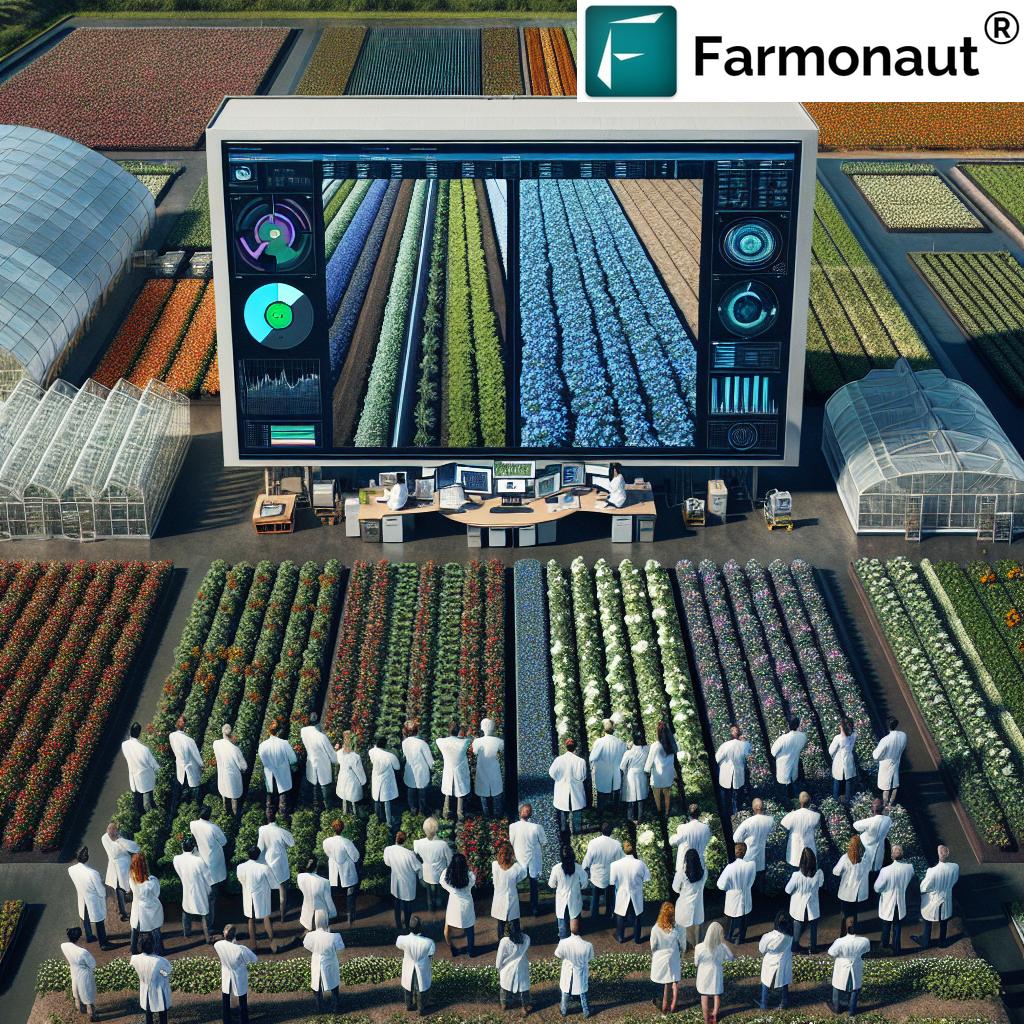
“Recent studies show biofungicides can increase crop yields by 20-30% while maintaining organic certification standards.”
Regulatory Landscape and Environmental Protection
The adoption of bee vectoring technology in agriculture has been met with rigorous scrutiny and subsequent approval from various environmental protection agencies. This process underscores the technology’s safety and efficacy:
- EPA Approval: In the United States, the Environmental Protection Agency has granted approval for the use of certain strains of Clonostachys rosea in bee vectoring systems, recognizing its potential in sustainable pest management.
- International Recognition: Beyond the U.S., countries like Canada and Mexico have also approved this technology, paving the way for broader international adoption.
- Ongoing Research: Continuous studies are being conducted to assess long-term impacts and optimize the use of bee vectoring in various crops and environments.
These regulatory approvals are crucial in building confidence among growers and consumers alike. They validate the safety and effectiveness of bee vectoring as a sustainable crop protection method, aligning with global efforts to reduce chemical inputs in agriculture.
Challenges and Future Prospects
While bee vectoring technology shows immense promise, it’s not without its challenges:
- Weather Dependence: The effectiveness of bee vectoring can be influenced by weather conditions, as bees are less active during cold or rainy periods.
- Crop Specificity: The method is most effective in crops that rely heavily on bee pollination, limiting its application in some agricultural sectors.
- Adoption Barriers: Some growers may be hesitant to adopt new technologies, particularly those that require a shift in pest management strategies.
However, the future looks bright for this innovative approach. Ongoing research is focused on:
- Expanding the range of biological control agents that can be vectored by bees
- Developing strategies to overcome weather-related limitations
- Exploring the use of other pollinator species as vectors
- Integrating bee vectoring with other precision agriculture techniques for comprehensive crop management
At Farmonaut, we’re committed to tracking these developments and providing farmers with the latest insights and tools to leverage these innovative farming practices effectively.
The Role of Precision Agriculture in Enhancing Bee Vectoring Efficacy
As we delve deeper into the synergies between various sustainable agriculture technologies, it’s clear that precision agriculture techniques play a crucial role in maximizing the benefits of bee vectoring. At Farmonaut, we understand the importance of integrating multiple approaches for optimal farm management.
- Satellite Monitoring: Advanced satellite imagery can help identify areas of crop stress or disease outbreaks, allowing for targeted application of bee vectoring technology.
- Weather Forecasting: Accurate weather predictions enable farmers to optimize the timing of hive placement and vector application, ensuring maximum bee activity and efficacy.
- Data Analytics: By analyzing historical and real-time data, farmers can make informed decisions about when and where to implement bee vectoring for the best results.
These precision agriculture techniques, when combined with bee vectoring, create a powerful toolkit for sustainable crop management. They allow for a more nuanced and efficient approach to pest and disease control, further reducing the need for chemical interventions.
For those interested in leveraging cutting-edge satellite technology for farm management, Farmonaut offers comprehensive solutions. Explore our web application or download our mobile apps for Android and iOS to get started.
Economic Implications for Farmers
The adoption of bee vectoring technology presents significant economic opportunities for farmers, particularly in high-value crops like blueberries:
- Reduced Input Costs: By decreasing the reliance on chemical fungicides, farmers can substantially lower their input costs.
- Increased Yield: The dual benefit of improved pollination and disease control often results in higher yields and better fruit quality.
- Premium Market Access: Produce grown using sustainable methods often commands premium prices in the market, especially in organic and eco-conscious consumer segments.
- Labor Savings: The reduction in spray applications translates to lower labor costs and reduced equipment wear and tear.
While the initial investment in bee vectoring systems may be a consideration, the long-term economic benefits often outweigh the costs, especially when factoring in the environmental and health benefits.
Comparative Analysis: Bee Vectoring vs. Traditional Methods
To better understand the advantages of bee vectoring technology, let’s compare it with traditional crop protection methods:
| Aspect | Bee Vectoring Technology | Traditional Crop Protection |
|---|---|---|
| Environmental Impact | Minimal; supports pollinator health | Potential for soil and water contamination |
| Effectiveness against Mummy Berry Disease | High; targeted delivery to flowers | Variable; depends on spray coverage |
| Cost Efficiency | Lower long-term costs; reduced inputs | Higher recurrent costs for chemicals and application |
| Regulatory Approval Status | Approved in multiple countries | Varies; some chemicals facing restrictions |
| Compatibility with Organic Farming | Highly compatible | Limited; many synthetics not allowed |
| Application Process | Continuous through bee activity | Periodic spraying required |
| Impact on Pollinators | Beneficial; supports bee populations | Potential negative impacts |
| Long-term Sustainability | High; promotes ecosystem balance | Concerns over resistance and ecosystem disruption |
This comparison clearly illustrates the advantages of bee vectoring technology in terms of environmental protection, sustainability, and compatibility with organic farming practices.
Global Implications and Food Security
The potential of bee vectoring technology extends far beyond Georgia’s blueberry fields. As we face global challenges in food security and sustainable agriculture, this innovative approach offers promising solutions:
- Reduced Chemical Dependence: By providing an effective alternative to chemical pesticides, bee vectoring contributes to global efforts to reduce agricultural chemical use.
- Climate Change Adaptation: As climate patterns shift, affecting pest and disease pressures, adaptable and eco-friendly solutions like bee vectoring become increasingly valuable.
- Biodiversity Conservation: By supporting pollinator populations and reducing broad-spectrum pesticide use, this technology aids in preserving biodiversity in agricultural landscapes.
- Food Quality Improvement: The reduction in chemical residues on crops aligns with growing consumer demand for cleaner, healthier food options.
These global implications underscore the importance of continued research and development in sustainable agriculture technologies. At Farmonaut, we’re committed to supporting these advancements through our precision agriculture tools and data-driven insights.
The Future of Crop Protection
As we look to the future of crop protection, it’s clear that technologies like bee vectoring will play an increasingly important role. The integration of biological control agents, precision agriculture techniques, and data-driven decision-making is shaping a new paradigm in sustainable food production methods.
- Expanding Crop Applications: Research is ongoing to adapt bee vectoring technology for use in a wider range of crops, including tree fruits, vegetables, and field crops.
- Advanced Formulations: Scientists are working on developing new biological control agents and improved formulations for even greater efficacy and ease of use.
- Smart Hive Technology: The integration of IoT devices in beehives could provide real-time data on bee activity and vector distribution, further enhancing the precision of this method.
- Policy Support: As governments worldwide focus on sustainable agriculture, we can expect increased policy support and incentives for adopting eco-friendly pest management solutions.
For farmers and agricultural professionals looking to stay ahead of these trends, Farmonaut offers cutting-edge satellite monitoring and data analysis tools. Our API and developer documentation provide access to powerful agricultural insights that can complement and enhance the use of innovative technologies like bee vectoring.
Conclusion: A Sustainable Path Forward
The revolution in sustainable agriculture, exemplified by bee vectoring technology in Georgia’s blueberry fields, marks a significant milestone in our journey towards more environmentally friendly and productive farming practices. This innovative approach not only addresses the immediate challenges of crop protection but also aligns with broader goals of sustainability, biodiversity conservation, and food security.
As we’ve explored throughout this article, the benefits of bee vectoring are multifaceted:
- Enhanced crop protection with minimal environmental impact
- Improved yields and fruit quality
- Reduced reliance on chemical pesticides
- Support for pollinator populations
- Alignment with organic farming practices
- Economic advantages for farmers
The success of bee vectoring in Georgia’s blueberry industry serves as a compelling case study for the potential of this technology in other crops and regions. As research continues and the technology evolves, we can expect to see even more applications and refinements that will further revolutionize sustainable agriculture.
At Farmonaut, we’re excited to be part of this agricultural revolution. Our satellite-based farm management solutions complement innovative technologies like bee vectoring, providing farmers with the data and insights they need to make informed decisions and optimize their operations. By combining precision agriculture techniques with sustainable pest management solutions, we’re helping to pave the way for a more productive, environmentally friendly, and food-secure future.
As we move forward, it’s clear that the future of agriculture lies in these smart, sustainable solutions. Bee vectoring technology is just one example of how innovative thinking and respect for natural processes can lead to remarkable advancements in farming practices. By embracing these technologies and continuing to innovate, we can ensure a healthier planet and a more secure food supply for generations to come.
FAQ Section
Q: What is bee vectoring technology?
A: Bee vectoring technology is an innovative method of crop protection that uses bees to deliver beneficial microbes directly to crop flowers during pollination, providing targeted pest and disease control.
Q: How effective is bee vectoring in controlling mummy berry disease in blueberries?
A: Bee vectoring has shown high effectiveness in controlling mummy berry disease in blueberries, with studies indicating significant reductions in disease incidence compared to traditional methods.
Q: Is bee vectoring technology approved for use in organic farming?
A: Yes, bee vectoring technology using approved biological control agents is compatible with organic farming practices and meets organic certification standards.
Q: What are the environmental benefits of bee vectoring?
A: Bee vectoring reduces the need for chemical pesticides, supports pollinator health, and promotes biodiversity, resulting in a lower environmental impact compared to traditional crop protection methods.
Q: Can bee vectoring be used in crops other than blueberries?
A: While currently most effective in crops that rely heavily on bee pollination, research is ongoing to expand the use of bee vectoring to a wider range of crops, including sunflowers, strawberries, and tree fruits.
Stay informed about the latest developments in sustainable agriculture and precision farming techniques by exploring Farmonaut’s comprehensive suite of tools and resources. Our commitment to innovation and sustainability aligns perfectly with the transformative potential of technologies like bee vectoring, ensuring that farmers have access to the most advanced and environmentally friendly solutions available.






